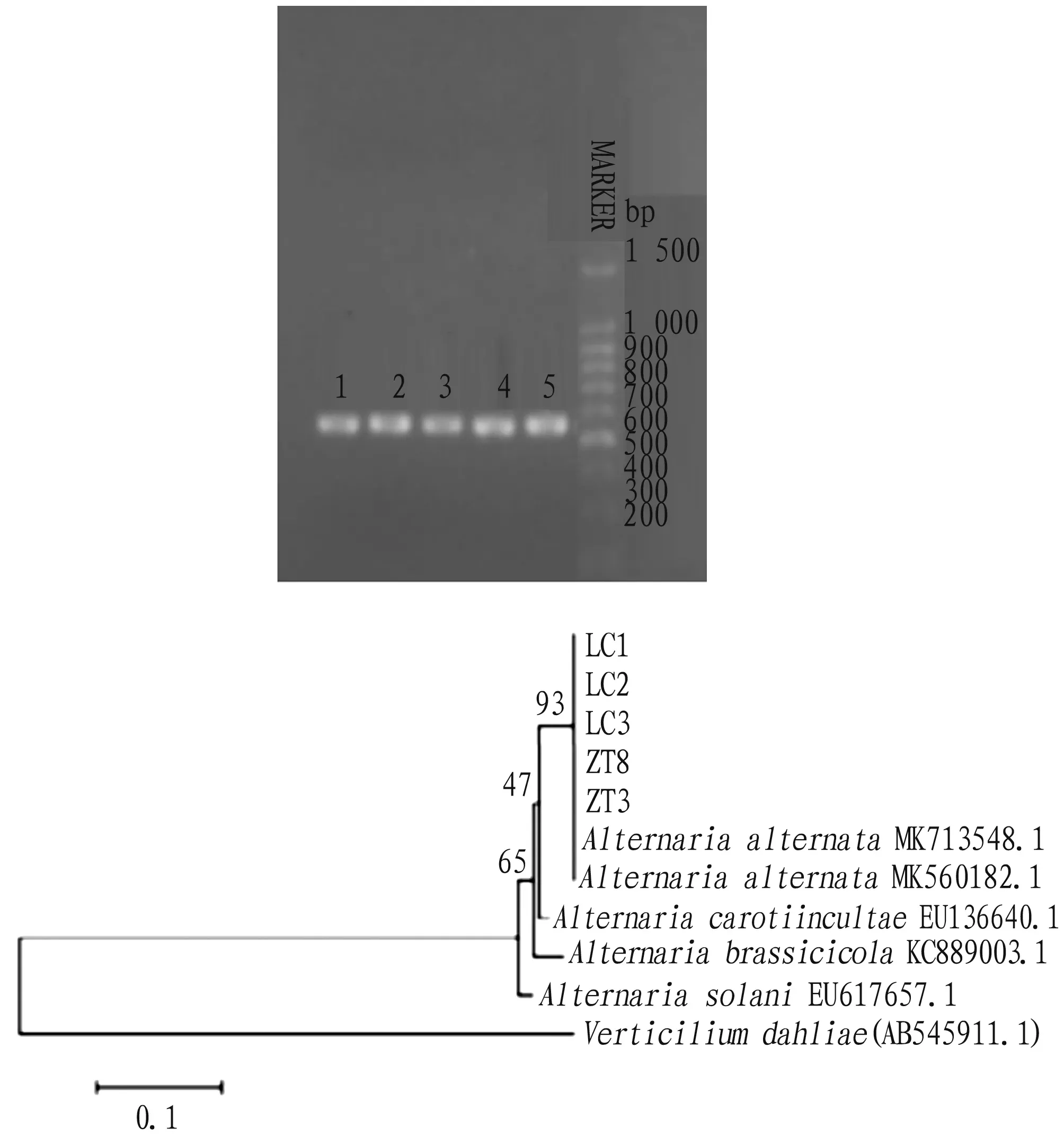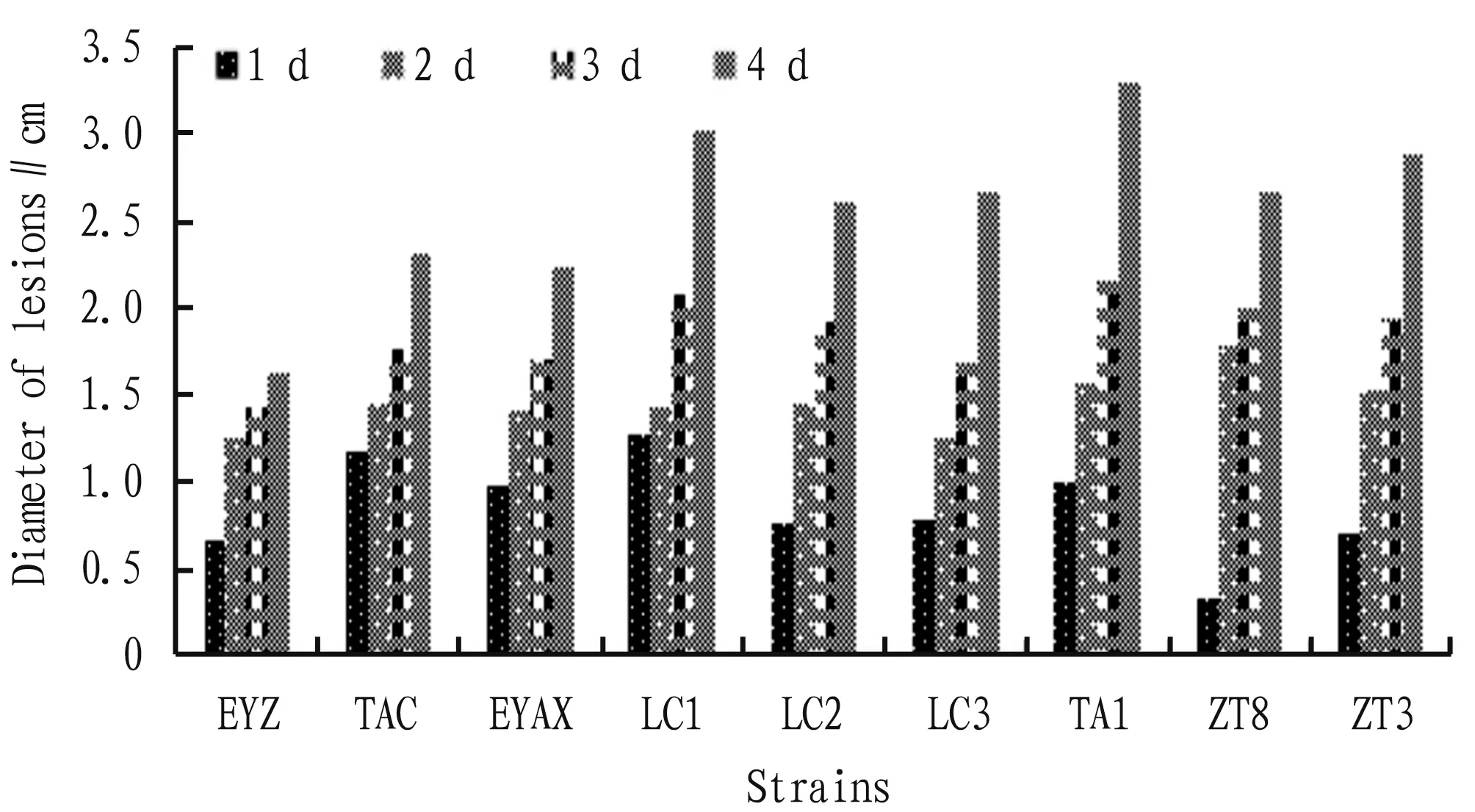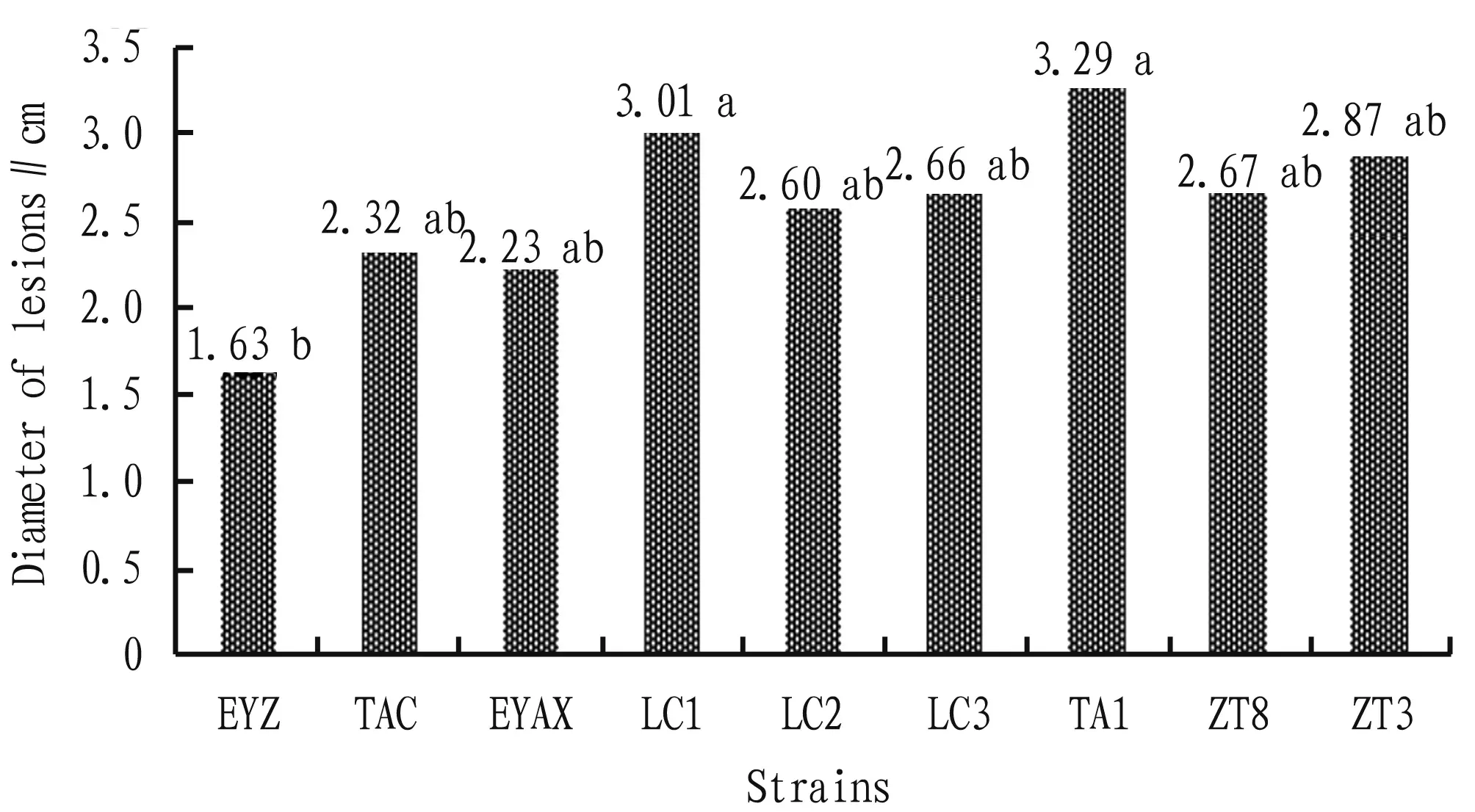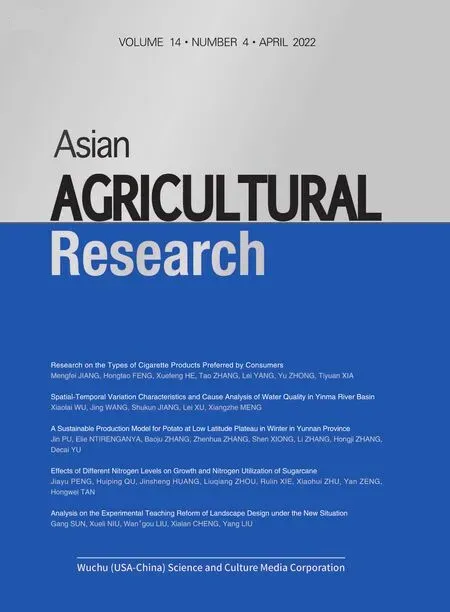Occurrence and Damage and Pathogene of Potato Early Blight in Winter in Yunnan Province, China
Zhenhua ZHANG, Shen XIONG, Li ZHANG, Baoju ZHANG, Jin PU, Min TU, Jianbo ZHANG, Decai YU*
1.College of Plant Protection, Yunnan Agricultural University/Key Laboratory of Agricultural Biodiversity and Pest Control, Ministry of Education, Kunming 650201, China; 2.Rubber Research Institute, Chinese Academy of Tropical Agricultural Sciences, Danzhou 571737, China; 3.Foreign Cooperation Office of Yunnan Provincial Academy of Science and Technology, Kunming 650228, China
Abstract [Objectives]The paper was to understand the species and pathogenicity of the pathogen causing potato early blight in winter.[Methods]The occurrence of potato early blight was investigated in 5 winter potato growing areas in Yunnan Province.The disease samples were collected from two locations(Zhutang Village and Zhanai Village, Pu’er City)where the occurrence of early blight was severe.The pathogen was isolated and purified in laboratory and identified by morphological characteristics and phylogenetic analysis of ITS gene sequence.And it was further verified via re-inoculation by Koch’s rules.The growth characteristics and pathogenicity of isolates in different seasons were analyzed with 4 strains of Alternaria isolated in spring(EYZ, EYAX, TA1 and TAC)as controls.[Results]Early blight occurred in varying degrees in the 5 winter potato growing areas, and the incidence of early blight was up to 100% in some plots in Lancang County, Pu’er City.A total of 35 strains of Alternaria were isolated from plots with high incidence, which were divided into two types according to colony morphology.The first type was round colonies with smooth edges and gray white fronts, and the second type was round colonies with rough edges and gray black fronts.Three strains LC1, LC2, LC3 of the first type and two strains ZT3 and ZT8 of the second type were selected and identified as Alternaria alternata through morphological and molecular identification.Re-inoculation test further confirmed that the pathogen was A. alternata.Meantime, it was found that the growth rate of colonies isolated in winter was relatively slow, and there was no significant difference between the pathogenicity of LC1 and TA1, but the pathogenicity of strains isolated in winter was generally higher than that isolated in spring.[Conclusions]It is confirmed that the pathogen causing potato early blight in winter is A. alternata in Yunnan Province.The results will lay a foundation for the research of pathogenesis, occurrence regularity and disease control of A. alternata in winter potato.
Key words Alternaria, Potato early blight, Morphological characteristics, Pathogenicity
1 Introduction
Potato early blight is a worldwide disease, which occurs in major potato producing areas all over the world.The occurrence area of potato early blight in China accounts for about 20% of the total potato planting area.The incidence rate in Yunnan Province reaches up to 5%-10% on average, or even 90%-100% in severe plots[1-2].In recent years, Yunnan has developed into the largest winter potato producing area in China due to the unique climatic conditions of low latitude plateau, with the winter potato planting area exceeding 3 billion ha[3].Low temperature and low rainfall in winter can avoid the occurrence of late blight to a certain extent in Yunnan Province, but in recent years, it has been found that the occurrence of potato early blight in winter is faster than that in spring.The pathogen has stronger pathogenicity, becoming the main potato disease in winter.Therefore, determining the species and pathogenicity of potato early blight in winter not only provides a basis for revealing the occurrence regularity of potato early blight in winter, but also has important significance for disease control and industrial development.
The pathogen causing potato early blight belongs toAlternaria, Dematiaceae, Moniliales, Hyphomycetes, Deuteromycotina.At present, more than 500 species ofAlternariafungi have been reported internationally, and new species are constantly being discovered[4], more than 95% of which can cause crop diseases.The pathogenic fungi that cause potato early blight includeA.solani,A.alternata,A.tenuissima,A.arborescens,A.grandis,A.interrupta,A.infectoriaandA.dumosa, among whichA.solaniis the dominant pathogenic population[5].A.alternatawas once considered by Weiretal.[6]to be unable to cause the occurrence of potato early blight alone.Later experiments proved that bothA.alternataandA.solanicould cause the occurrence of potato early blight separately[7], soA.alternatais also the main pathogen causing potato early blight.And the potato early blight caused by the two pathogens could not be distinguished from the appearance[8].Heetal.[9]isolatedA.solanifrom susceptible leaves of potato early blight collected from Kunming, Yunnan Province.Mengetal.[10]isolatedA.alternatafrom susceptible leaves of potato early blight in Yunnan Province, and identified that its pathogenicity was higher than that ofA.alternatacollected from Fujian, Shandong, Henan, Hubei, Inner Mongolia and Heilongjiang provinces.Therefore, there are regional differences in the distribution and pathogenicity ofAlternariastrains causing early blight.Currently, the pathogen of winter potato early blight in Yunnan Province has not been reported yet.The research group investigated the occurrence of winter potato early blight, and carried out the species identification and pathogenicity research of the pathogen causing early blight.Samples were collected from key areas of potato early blight in winter in Yunnan Province, and the pathogenic strains were confirmed by morphological and molecular identification.The differences in growth characteristics and pathogenicity betweenA.alternataisolated in winter and spring were analyzed, providing a basis for the study on the incidence regularity and control of early blight in winter.
2 Materials and methods
2.1 MaterialsStrains EYZ, EYAX, TA1 and TAC isolated in spring were provided by the Laboratory of Potato Pest Ecological Management, College of Plant Protection, Yunnan Agricultural University.
The PDA medium(200 g potato, 20 g agar, 20 g glucose, 1 000 mL water)was used for the separation and sporulation ofAlternariastrains.
2.2 Disease investigation sampling and pathogen isolation and purificationAn investigation was conducted on the occurrence of early blight in 5 winter cropping areas of Yunnan Province(Dehong Prefecture, Honghe Prefecture, Wenshan Prefecture, Pu’er City and Lincang City).Samples of potato early blight were collected from Zhanai Village and Zhutang Village in Lancang County, Pu’er City, Yunnan Province, where the disease severely occurred, and the pathogen was isolated(planting on November 15, and harvesting at the end of March).The pathogen was isolated by conventional tissue separation[11].A leaf tissue about 0.4 cm in length and width was cut from the junction of diseased leaves, put into petri dishes with sodium hypochlorite and 75% alcohol respectively for surface disinfection, then rinsed with sterile water for 2-3 times, and placed on ultra-clean worktable for air drying.The air drying leaf samples were placed onto the prepared PDA medium and incubated at 28 ℃.Afterwards, the growing mycelia were picked out and repeatedly transferred to new PDA medium for later use.The pathogen was purified by water agar culture method, and the cultural fungal cake was placed in 1% water agar medium under dark conditions at 25 ℃ to produce a large number of spores.After 3 d, a few mycelia on water agar medium were scraped off with an inoculation needle, and streaked and diluted on the new water agar medium until only one spore could be seen in the microscope field.The monospora was transferred from water agar medium to PDA medium for incubation, and the purified strain was obtained[9,12].
2.3 Morphological identification of the pathogenThe purified pathogens were inoculated on PDA medium, and the morphology, size and color of the colonies were observed and statistically described every day.After incubation for 8 d at 25 ℃, the size, shape, vertical and horizontal septa, presence of beaks, morphological characteristics of conidiophores and mycelia were observed under an optical microscope[13].
2.4 Identification of the pathogen at molecular levelThe mycelia of the pathogenic strain that had been cultured on PDA medium at 28 ℃ for 8 d were picked, and its genomic DNA was extracted by kit method to amplify the ITS sequence.The samples were amplified by PCR using universal primers ITS1(5’-TCCGTAGGTGAACCTGCGG-3’)and ITS4(5’-TCCTCCGCTTATTGATATGC-3’).PCR was performed in a 20 μL system containing 2 μL of DNA, 1.6 μL of dNTPs, 0.5 μL of each primer, 2.0 μL of 10X HA Taq Buffer, 0.2 μL of High Affinity HotStartTaq, and 13.2 μL of ddH2O.The specific steps of PCR were as follows: pre-denaturation at 95 ℃ for 3 min, denaturation at 95 ℃ for 30 s, renaturation at 55 ℃ for 30 s, 35 cycles; extension at 72 ℃ for 1 min, supplement extension at 72 ℃ for 5 min.Afterwards, agarose gel electrophoresis was performed.The ITS sequences of the tested strains were amplified by PCR, and compared with the published sequences in NCBI database.The phylogenetic tree was constructed with MEGA5.0 software to determine the species of the pathogen.
2.5 Re-inoculation and testing by Koch’s ruleThe pathogenicity was tested by Koch’s rule.Theinvitroleaves were rinsed repeatedly with sterile water, then soaked in 75% alcohol for 2 min, and rinsed with sterile water for three times.The pathogenic strains were punched with a sterilized puncher, and the fungal cakes were directly inoculated in the center of potato leaves.Each strain had 5 replicates.For the blank control, PDA medium was punched and directly inoculated in the middle of healthy isolated leaves[14], and moisturized and incubated at 25 ℃.The incidence was observed, and the pathogenic strain was re-isolated from the diseased leaves for identification.The above tests were repeated three times.
2.6 Determination of growth rate of the pathogenThe pathogenic strains were punched with a sterilized puncher, and the fungal cakes were directly inoculated in the center of PDA medium.The media were incubated in darkness at 25 ℃ for 8 d.The growth of the colonies was observed every day, and the growth diameter of the colonies was measured.
2.7 Pathogenicity analysisThe 9 pathogenic strains were punched with a sterilized puncher, and the fungal cakes were directly inoculated in the center of the treated potato leaves.Each strain had 5 replicates respectively, and the blank control was set up.The samples were moisturized and incubated at 25 ℃.The incidence of the leaves was observed, and the diameter of the lesions was recorded once every 24 h for consecutive 7 d after the incidence of the disease.
2.8 Statistical analysis methodAll data were statistically analyzed by Excel, DPS and SPSS.
3 Results and analysis
3.1 Field incidence of potato early blight in winter
3.1.1Field symptoms of the disease.In recent years, the planting area of winter potato in Yunnan had been expanding, and the occurrence of early blight was relatively light in the early planting stage, but the occurrence and harm of early blight had become more and more severe since 2018.Field symptoms were characterized by the appearance of round brown lesions on old leaves in the initial stage(Fig.1A), and then small brown spots gradually spread to form irregular round or elliptic black-brown rings(Fig.1B).At 1-2 d after rainfall, early blight spread rapidly and some plants died(Fig.1C).

Note: A.Characteristics of lesions in the initial incidence stage; B.Plant symptoms in the late incidence stage; C.Large area incidence in the field.
3.1.2Field occurrence.An investigation of early blight was carried out in 5 prefectural regions of Yunnan Province where potatoes were planted in winter.The results showed that potato early blight commonly occurred, and the incidence and severity of potato early blight varied among different regions.From the perspective of occurrence and harms, some plots in Lancang County,Pu’er City were severely attacked, with the highest incidence of 100%, which greatly affected the field yield.
3.2 Pathogen isolation and morphological identificationIn 2018, a total of 35Alternariastrains were isolated from Zhanai Village and Zhutang Township, two plots of Lancang County, Pu’er City, Yunnan Province, where the incidence of potato was high.The first type was round colonies with smooth edges.The front side of the colony was gray white and the back side was dark brown with concentric rings.The second type was round colonies with rough edges.The front side of the colony was gray black and the back side was dark brown with concentric rings(Fig.2).Three strains LC1, LC2 and LC3 of the first type and two strains ZT3 and ZT8 of the second type were selected to observe their morphological characteristics(Table 1).The results showed that the mycelia of 5 strains all had septa and branches and could produce spores on PDA medium.The spores of first type were dark brown and that of the second type were yellowish-brown.The spores of the second type were in varying shapes, such as oval, clavate,etc.; the conidia were beakless or shortly beaked, with beaks conical or cylindrical.

Note: A,B, C.The front and back of the colony and spore morphology of the first type; D, E, F.The front and back of the colony and spore morphology of the second type.

Table 1 Morphological characteristics of spores
3.3 Molecular identification of the pathogenThe 5 strains isolated in winter were amplified by PCR, and the size of the ITS sequences were all about 550 bp.Blast comparison showed that the similarity between ITS sequences of these 5 pathogenic strains andA.alternariawas 99%.The phylogenetic tree of the measured sequence and the reference sequence published in NCBI database was constructed by MEGA5.0 software.The results demonstrated that the ITS sequences of 5 strains were clustered withA.alternata(Fig.3).After molecular identification and morphological identification, 5 strains isolated from winter potato disease samples could be confirmed asA.alternata.

Note: 1.LC1552 bp; 2.LC2547 bp; 3.ZT3552 bp; 4.ZT3552 bp; 5.ZT8551 bp.
3.4 Pathogenicity detection of the pathogenFiveAlternariastrains were subjected to re-inoculation test.At 7 post inoculation, the incidence rate of the plants was 100%.The lesions were yellowish brown and spread from the inoculation site to all sides.The pathogen was re-isolated from the diseased leaves(Fig.4), and carried out morphological and molecular identification.The results proved that it was consistent with the previous pathogen, conforming to Koch’s rule.Therefore,A.alternatawas identified as the pathogen of winter potato early blight in Yunnan Province.

Note: A, B, C, D and E represent the incidence of leaves inoculated with LC3, ZT3, LC1, ZT8 and LC2, respectively.
3.5 Colony growth difference ofA.alternataisolated in different seasonsIt was reported that the pathogenicity ofA.alternatawas related to mycelial growth.The colony diameter ofA.alternataisolated in spring was 1.29 cm on the 1stday of inoculation, and that isolated in winter was 1.08 cm.The colony diameter entered a period of rapid growth on the 2ndday, and then a period of steady growth.The overall growth rate of spring isolates was slightly faster than that of winter isolates throughout the incubation for 8 d(Table 2).

Table 2 Growth rate of colonies cm
3.6 Difference in pathogenicity ofA.alternataisolated in different seasonsIn theinvitroinoculation test, all the leaves began to develop sporadically 48 h after inoculation(Fig.5).The leaves around fungal cakes were initially light yellowish green, then changed from light yellowish green to yellow.The lesions were irregular in shape, which gradually spread outward from the inoculation site.On the 5thto 6thday after inoculation, obvious brown lesions appeared and gradually spread outwards.The leaves of blank control did not change.On the 7thday, the lesions had rapidly expanded to more than 80% of the whole leaf area.From the 1stday of incidence, the investigation found that the disease lesions caused by spring isolates were larger than those caused by winter isolates in the early stage, but the growth rate of lesions lowered in the late stage.However, the growth rate of lesions of 5 isolates in winter was very fast, and the diameter of lesions could expand to about 3 cm on the 4thday, providing suitable conditions for the prevalence of the disease.

Fig.5 Extension of lesions on leaves inoculated with Alternaria alternata
According to the size of lesions(Fig.6), the maximum diameter of lesions was caused byA.alternataTA1 isolated in spring(3.29 cm), followed by the winter isolate LC1(3.01 cm), while the minimum diameter of lesions was caused by the spring isolate EYZ(1.63 cm).Therefore, the pathogenicity of the spring isolate TA1 and the winter isolate LC1 was significantly higher than that of EYZ and other strains.The lesions caused byA.alternataisolates in winter were larger than those caused by isolates in spring, but there was no significant difference among 5 isolates in winter.

Fig.6 Difference in pathogenicity of different strains inoculated with leaves
4 Discussion
The damage of potato early blight to potato is second only to that of potato late blight, which is also a fungal disease.In this study, it was found that potato early blight in winter had fast incidence rate and wide range of harms in Yunnan Province, becoming the main disease of winter potato.Studies have reported that potato early blight easily occurs in high temperature and humidity.The disease begins when the temperature is above 15 ℃ and the relative humidity is above 80%.When the temperature is above 25 ℃, the disease will spread rapidly in case of short-term rain[15].Winter potato is planted from middle November to early April in Yunnan, during which there is sufficient light, and the occurrence of the disease is relatively light due to low temperature in the early stage.When the potato enters the budding stage, the maximum daily temperature exceeds 15 ℃ and the temperature in the flowering stage continues to rise to the maximum daily temperature of 25 ℃, early blight will rapidly occur and spread in case of short-term rainfall.This is in agreement with the findings of this survey.The identification results proved that the pathogen causing early potato blight in Yunnan was onlyA.alternaria, whileA.solaniwas the dominant pathogen causing early potato blight in other major potato producing areas such as Heilongjiang, Hebei, Shandong and Fujian[15].Meantime,A.solaniwas also isolated from the leaves of potato early blight in spring in Kunming, Yunnan Province[9].Because the distribution ofAlternariastrains is greatly affected by environmental factors, it is necessary to expand sampling sites and analyze meteorological characteristics of different sites, to further study their distribution rules.
Previous studies suggest that early blight is more likely to occur in winter and causes serious harms, which may be attributed to the changes of various physiological and biochemical reactions in plants due to low temperature in winter, resulting in metabolic disorder, massive accumulation of ROS, membrane lipid peroxidation, and destruction of the structure and function of cell membranes[16].Pathogens are more likely to invade into potato cell wall in case of low temperature injury, and their colonization rate and sporulation rate are accelerated after invasion[17].After the pathogen infects the host plant, it will affect the levels of some hormone by secreting some or several hormone substances, resulting in maladjustment of hormone ratio and pathological reaction.The vegetative growth rate of pathogens in winter slows down and the sporulation quantity increases.The hormones secreted by pathogens, such as GA3, can promote the infection of potato by pathogens, thus aggravating the harm of early blight[18].Meanwhile, winter wind, rain and irrigation in Yunnan are conducive to the conidia transmission ofAlterniellastrains and accelerate the occurrence and prevalence of the disease.
5 Conclusions
Early blight occurred in different degrees in Yunnan winter potato growing areas, and the incidence of severe plots was up to 100%.A total of 35 Alterniella strains were isolated and purified from the diseased leaves of plots with high incidence of potato early blight in winter, which were divided into two types according to colony morphology.A total of 5Alternariastrains were selected for morphological and molecular biological identification, and the results showed that all the 5 pathogenicAlternariastrains wereA.alternaria.The mycelia growth of isolated strains in winter was slower than that of isolated strains in spring, but the pathogenicity was relatively strong.
 Asian Agricultural Research2022年4期
Asian Agricultural Research2022年4期
- Asian Agricultural Research的其它文章
- A Sustainable Production Model for Potato at Low Latitude Plateau in Winter in Yunnan Province
- Chromatograph Skeleton Components of Feng-flavor Baijiu during Different Production Stages
- Analysis and Strategy Research on the Mathematics Learning Situation of the Postgraduate Candidates
- Application of ETA in the Management of Mental Health Education for College Students
- Research on the Types of Cigarette Products Preferred by Consumers
- Current Situation of E-commerce Entering Rural Areas in Datong County of Qinghai Province
